
Earlier this week, I had a friend tell me that she was trying to set a boundary with her husband. She told me how, in the middle of a fight, she had screamed at him that he was crossing her boundary and he responded by laughing. She felt hurt and invalidated. I felt her pain while she was telling me her story. I asked her what her boundary was and how she had communicated this with him. She explained that she had decided at that moment what her boundary was and that he was crossing it. I quickly remembered all my failed attempts at setting boundaries in the past and how much research I had done to finally set successful boundaries. After this conversation, I decided to postpone my article on the third part of our passive-aggressive series and talk about boundaries this week.
When we were first married, my husband and I bought a parcel of land in a new subdivision to build our first home. This plot had a house built on one side of it but an empty lot to the right. We were excited because it was one of the bigger lots in the neighborhood and had a small lake at the back of the property. During the land survey, the company that was hired buried land markers on the outskirts of our property. A few years later, we moved because of my husband’s job. We rented the house out for almost 15 years and a new home was built on the empty lot next door. When it was time to put the house up for sale, we needed a new land survey and the original company that performed the survey came back out to do it. What he found was that the neighbor that had built a house on the lot next door had moved the markers so he could build a fence and have access to the lake. Now he would need to move his fence back 3 feet before we could sell our home. In the coming months, a battle over the boundary line would ensue. Here, we had a clear boundary and he decided he did not like that boundary. Probably in the middle of the night, he went outside, dug up the boundary markers, and placed them where he wanted them. He changed the boundaries and we did not realize it for years. How does this relate to the boundaries that we set in our own lives? Let me explain.

We are all told we need to have boundaries in our life, especially in our relationships. We hear people say all the time, “that crossed my boundary,” “ I have a firm boundary with that” or “if they cross my boundary one more time I am going to leave!” We go about setting boundaries in our lives and wondering why people are crossing them and we have no idea what to do when they do. It’s frustrating and leads to chaos in our lives.
When I first started my journey from chaos to calmness, I began doing research on boundary setting, I quickly realized everything I knew about boundaries was, well, wrong. My basic understanding of boundaries was that they were lines in the sand that I drew to control what someone did to me. That line was firm and immovable, just like the land markers on the house we owned. I believed that all the boundaries in my life were required to stay in one spot and if moved, they needed to be quickly put back into place even if a huge battle would ensue. Was this the proper way to set a boundary? I had a long way to go before I would realize the proper and effective way to set a boundary.

I will admit, I grew up in a home that had very lax boundaries. Boundaries were not a term used in the 70s or 80s, at least not in our home. We had rules. We had consequences, sometimes. We had things that we knew we could not do. But we had no “boundaries.” This was a fairly new term for me and I was determined that I would learn to set good boundaries in my life.
During the beginning of my research, I had searched out and interviewed many people to listen to their stories about their boundary-setting experiences. Many of these stories sounded like ultimatums and demands, not healthy boundaries. These stories also ended with ineffective results and left them feeling, well, powerless, to change their situations. Here are two examples of their boundary-setting journeys.
“I set a boundary! I told him if he swore at me again in anger, it was over!”
“ I set a boundary with my son finally! I told him if he continued to come home late he could move out!”
This did not sound healthy to me. With this in mind, the first question I wanted to research was to determine what was the actual difference between an ultimatum and a boundary. According to Merriam Webster’s dictionary, an ultimatum is a final proposition, condition, or demand especially: one whose rejection will end negotiations and cause a resort to force or other direct action. Sadly, an ultimatum is usually used by a stronger person to control the actions of a weaker person. We can look at past wars to understand how an ultimatum typically works. A stronger country will give an ultimatum to a weaker country to gain power or influence over the actions of the weaker country. This may be effective in winning a war but highly unlikely to help you improve your communications skills. This is not what I was looking for. I did not want to annihilate my relationships, I wanted to repair them.

Now that I completely understood what an ultimatum was it was time to figure out my definition of what a boundary was to me. I had already discovered that it was not an ultimatum. It was time to begin writing down some examples of the types of things I needed to set boundaries about in my life, I recognized that I did not want to set boundaries that were directed at changing another person or their beliefs. These were boundaries for me, right? The goal was not to change another person, it was to determine what we will and will not tolerate in our own lives.
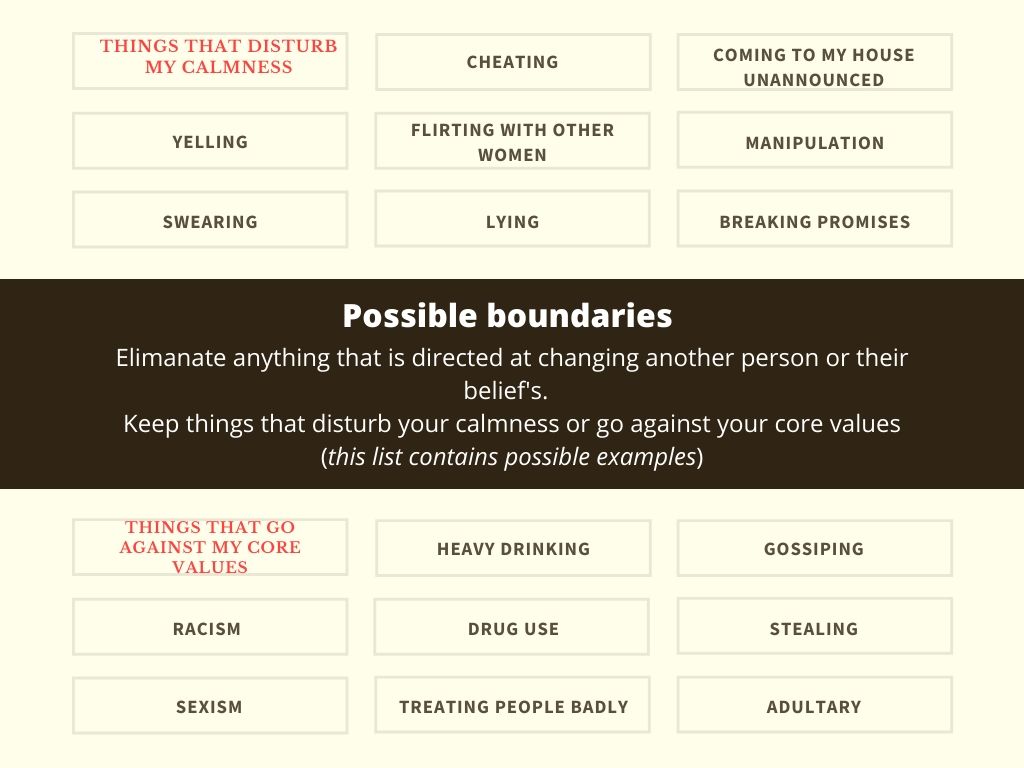
 Take a few minutes to start a list of ideas for your boundaries. Keep in mind while writing these, that the goal is not to change another person, it is to determine what we will and will not accept in our own lives.
Take a few minutes to start a list of ideas for your boundaries. Keep in mind while writing these, that the goal is not to change another person, it is to determine what we will and will not accept in our own lives.
In my notes from interviewing others, I had noticed that when people set boundaries, they often fail to be successful. Why was this? What I discovered through trial and error of setting boundaries in the next few months was life-altering. The main cause of these failed attempts was that I either tried to control the other person by stating how they needed to change to make my boundary successful or I did not explain what action I would take if my boundary was crossed. Where I once said, “I need you to stop yelling at me in anger, why don’t you work on not yelling at people!” I changed to “I need you to stop yelling at me in anger, I will leave the room every time you yell at me.” Here I stated, what I would do if this person yelled at me again, not what they needed to do.

To continue with this process of effectively setting boundaries, I referred back to that list I had written down on the things I needed to address with boundaries. After I added some more things to my list, I went back and crossed out anything that was controlling someone else’s behavior or beliefs and not addressing my needs. I went back through the list a second time and crossed off anything that could be addressed with clear communication.

What I was left with were the things on my list that I could not have in my life, things that disturbed my calmness or went against my core beliefs and values. Yelling, swearing at me, a spouse cheating or flirting with other women, lying or not telling me the whole truth, people showing up at my home unannounced and people acting in ways that manipulated my time or needs. The final part of my list consisted of values that I feel strongly against and did not want in my environment. Examples of these could be people who drink too much or do drugs, racism, sexism, treating people badly, or gossiping. I had narrowed down the list of things I could not and would not tolerate in MY life and in my environment. These things would contribute to chaos in my life and when searching for your calm, changes must be made. Now, that I knew WHAT I wanted to set boundaries for, it was time to figure out how.
I had my clear explanation of what a boundary was and was not and my list of what types of things that needed boundaries. My next challenge was how could I address these respectfully to a person who obviously was not being respectful, to me to begin with. I would not have to be setting boundaries if the person I was speaking to respected my feelings or needs to begin with. This was not so easy. I grabbed my handy pad and paper and went forward to try my new tools out.

My first few tries at setting boundaries were met with resistance and I had no idea why. The following is a list of things that I discovered through trial and error. Yes, these are the mistakes I made while figuring out this part of boundaries. I do feel empathy for my friends and family who were involved in my experiment with setting boundaries.
Ineffective tools for setting boundaries:
![]() I apologized for setting a boundary thus invalidating the importance of setting one.
I apologized for setting a boundary thus invalidating the importance of setting one.
![]() I gave an excuse while setting the boundary and because I gave an excuse, I made my presentation too long and often confusing. “I need to set this boundary because if I do not, I get anxiety so let me talk to you about what I am feeling….” ”I need to talk to you about this boundary because it has happened to me many times in the past, it’s not really you, but I need to set this with you.”
I gave an excuse while setting the boundary and because I gave an excuse, I made my presentation too long and often confusing. “I need to set this boundary because if I do not, I get anxiety so let me talk to you about what I am feeling….” ”I need to talk to you about this boundary because it has happened to me many times in the past, it’s not really you, but I need to set this with you.”
![]() I sounded angry when I set the boundary. Did I want the person to focus on my anger or my boundary? I had to remove the anger from my setting of my boundaries.
I sounded angry when I set the boundary. Did I want the person to focus on my anger or my boundary? I had to remove the anger from my setting of my boundaries.
![]() I forgot to make it about me. A few times while setting boundaries I worded my conversations in an attacking way by using the YOU word instead of the I word. I never want to attack the person I am setting a boundary with. Attacking always stalls communication.
I forgot to make it about me. A few times while setting boundaries I worded my conversations in an attacking way by using the YOU word instead of the I word. I never want to attack the person I am setting a boundary with. Attacking always stalls communication.

![]() I did not set a clear consequence to the action or I set an unclear, unrealistic consequence. I missed this the first few times! I set the boundary and either forgot to say what I would do if they crossed it or I said I would do something so ridiculous it was unattainable. Ex. If you continue to scare me with your driving, I will get out and walk home. I was not going to do this. So the consequence I set was not realistic.
I did not set a clear consequence to the action or I set an unclear, unrealistic consequence. I missed this the first few times! I set the boundary and either forgot to say what I would do if they crossed it or I said I would do something so ridiculous it was unattainable. Ex. If you continue to scare me with your driving, I will get out and walk home. I was not going to do this. So the consequence I set was not realistic.
This was a painful way to learn what not to do while setting boundaries but the lessons were clear and helped me to improve my boundary setting goals. After reviewing these failed attempts, I came up with a list of things I should do while setting boundaries.
![]() Effective tools for setting boundaries
Effective tools for setting boundaries ![]()
 Refrain from apologizing
Refrain from apologizing Do not make excuses for your boundary
Do not make excuses for your boundary Stay calm. Do not set a boundary when you are angry
Stay calm. Do not set a boundary when you are angry Remember boundaries are about what you need and what you will do
Remember boundaries are about what you need and what you will do State clearly what action you will take as a consequence, (what action YOU will do, e.g., leave the room, get off the phone, go home, reconsider the friendship)
State clearly what action you will take as a consequence, (what action YOU will do, e.g., leave the room, get off the phone, go home, reconsider the friendship)

So now, my boundary setting goals were well on the way to being successful! I still had a few things to address. First, how to prepare for having the discussion with the person I needed to set the boundary with and finally, how and when to address setting my boundary.
After recognizing the need for a boundary with a loved one or friend, I would have to address the issue directly. I read many articles during my research that stated that once you have the boundary set in your mind, there is no need to discuss it with the person. Boundaries were a personal thing that you would just recognize and follow through with your consequence without explaining it to the other person. This might work for someone else but for me this was ineffective. I wanted to improve my communication with others, not confuse them by suddenly walking out of the room or ending a conversation! I feel that to respectfully set boundaries the other person deserves the respect of knowing how you feel. It is not someone else’s responsibility to guess what you are feeling or to be expected to “mind read” your feelings and actions. Now I knew that I would address my boundaries with those involved.

I had discovered in my first attempts to set boundaries that being unprepared led to failed boundary setting. The question was now, how do I prepare my boundary before I present it to another person? This became a 4 step process.
- Recognize what the issue was that required a boundary . Make it clear and concise.
- Decide what my consequence would be if my boundary was crossed. Staying focused on what my action would be, not what they were required to do.
- Find a time to address the boundary when communication is not impaired due to distractions or address it the next time it happens directly.
- Be prepared for resistance depending on the personality of the person with whom I am setting a boundary.
Let’s discuss each one of these steps in depth to understand them better:
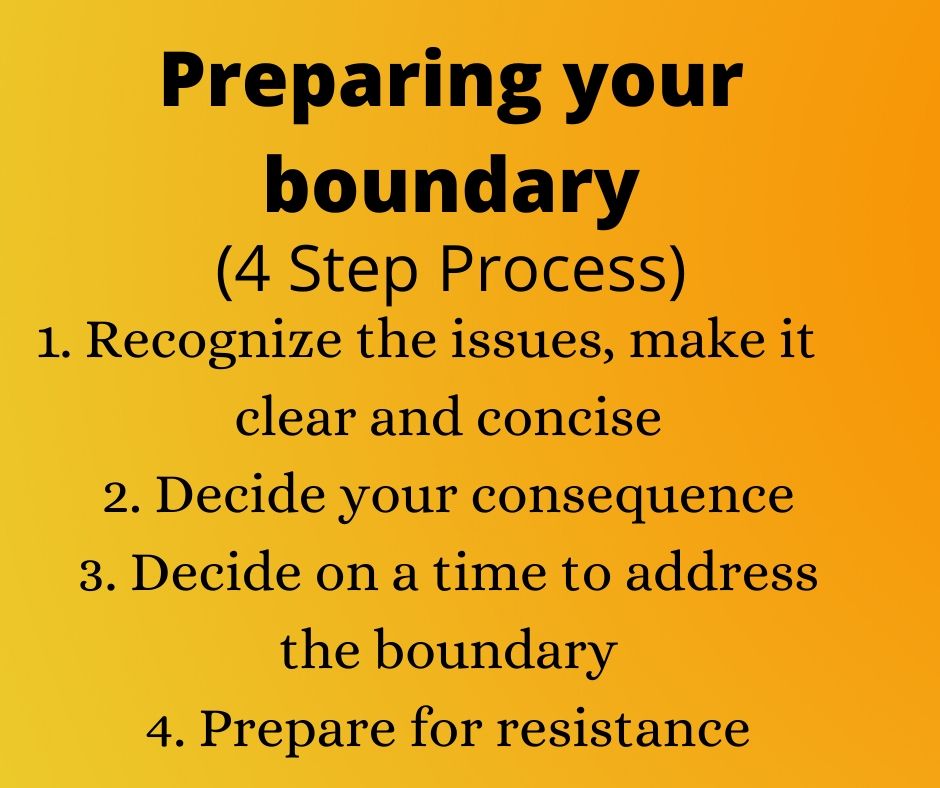
- Recognize what the issue was that required a boundary. Make it clear and concise.
I had already made my list of what things I would need to set boundaries for, so recognizing that a person in my life had crossed my personal boundary was paramount. I would need to write down the details of the situation to know exactly how I would present it. Here is our first example:
John, my brother in law, speaks badly of women and minorities. This is unacceptable to me. When he is around me and insults people based on their gender or race, I feel angry and disgusted. I think he thinks this is funny and makes his comments sound like jokes. This makes me uncomfortable and needs to be addressed the next time it happens. It is not my job to change his views or tell him how to live his life but it is my right not to have to be around this.
I would need to condense this to make sure when I finally do present this to John there would be no confusion as to what I was trying to say.
John, I do not appreciate comments that are sexist or racist. I do not find these funny and will not allow this kind of behavior in my life.
Here, I clearly stated what the offense was that crossed my boundary. I did not say when you do this, or you always do this. I stated I did not appreciate comments that are sexist or racist. This implies that it is not only him that I do not tolerate this from but everyone. I also addressed the fact that he makes his comments into jokes so I could cut off any excuse he may have such as “I was just joking” or “can’t you take a joke,” and that this is a firm boundary by stating that this is unacceptable to me no matter how it is presented.
The next step is to: 2. Decide what my consequence would be if my boundary was crossed. Staying focused on what my action would be, not what they were required to do.
In this example with John, it was now time to firmly tell him what I would do if he crossed this boundary again. Notice, I am not focusing on telling John how his actions are disgusting and he is narrow minded (although I would like to, I need to refrain).
John, I do not appreciate comments that are sexist or racist. I do not find these funny and will not allow this kind of behavior in my life. If this behavior continues, I will leave the room or leave the event we are attending.
When I state If this behavior continues, I will leave the room or leave the event we are attending, I am clearly telling John I will not stay and give him an audience to his behavior. I am stating what I will do if he does this again. He is very aware of what he has done to offend me and how I will react if he does it again.
My next step is to decide when to address my boundaries with the person. 3. Find a time to address the boundary when communication is not impaired due to distractions or address it the next time it happens directly.

After considering my two choices of addressing this in private or during the next offending event, I decided to address this the next time it happens. I take into consideration that John is my brother in law and the level of the boundary-crossing is at the top of my core values boundary list. Regardless of who is in the room or the situation. I will address this concern immediately. I am not doing this to shame or embarrass him, I am doing this so I can hit this issue head-on as it happens.
Finally, 4. Be prepared for resistance depending on the personality of the person with whom I am setting a boundary. There seem to be many reasons people feel that they can behave in any way they feel at any given moment. These people seem to feel strongly that they have a right to do and say everything that comes to the front of their minds, regardless of how hurtful it is or how offending it is. But while setting boundaries, this is not your responsibility to address how they feel or how they present themselves. We need to save that for the heated family debates or while sitting by the bonfire in the summer, not during our boundary setting moments. Each person you set a boundary with will react differently. The most difficult ones, the ones that are constantly crossing personal boundaries, will try to explain, debate, push back and shame you for having stood up for your beliefs. If this happens, stay firm and repeat your boundary calmly. If they continue, this gives you the perfect time to practice your consequence. In this case, to exit the room or the event. This is not the time to debate the topic at hand. This is very important to remember, you devalue your boundary, if you explain it or debate it!
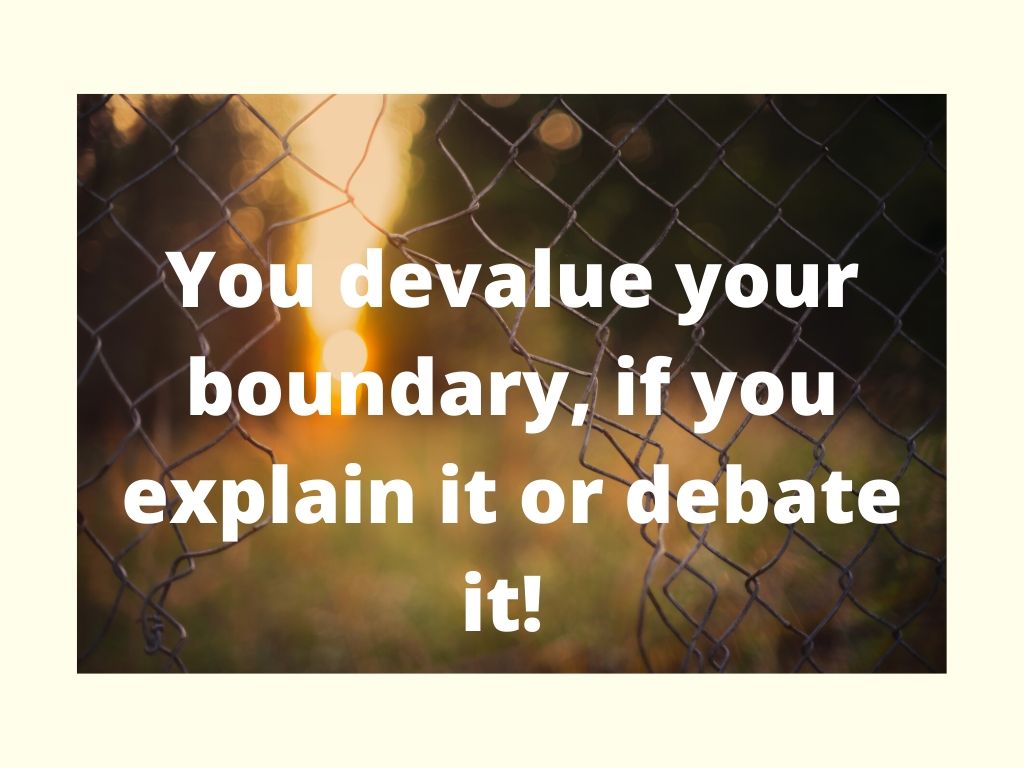
Lets quickly go through one more boundary setting process. In this example, we have a wife who is feeling hurt because her husband flirts with other woman and gives them compliments in front of her. First, she will need to write down the details of why she needs to set a boundary.
My husband, Mark, flirts and gives compliments to other woman when we are out. Sometimes it’s a stranger, like a waitress, other times a family friend. This not only hurts my feelings but embarresses me and makes me feel degraded.
She will need to condense this to present it to him.
Mark, when you flirt with, or compliment other women in front of me I feel hurt. embarrassed and degraded.
Her next step is deciding on a consequence if he continues to do this. She will have to remember while setting this step to explain what her actions will be.
Mark, when you flirt with, or compliment another woman in front of me I feel hurt, embarrassed and degraded. If this continues. I will end our night out and go home.
Now, she will need to decide when to approach this with her husband. This is an intimate relationship and addressing it next time it happens could be uncomfortable for her in front of the woman he is speaking with (notice how she considers what is comfortable for her, not him). She decides to discuss this with him in the privacy of her home when they are not arguing, not feeling stressed and when she can calmly set her boundary.
Finally, she needs to be prepared for him to push back on her boundary. He may do this by telling her she is overreacting, she is imagining things or that he is only being social. Here is where she can just simply state her boundary one more time.
Mark, when you flirt or compliment another woman in front of me I feel hurt, embarrassed and degraded. If this continues I will end our night out and go home.
There is absolutely no need to justify or explain her feelings. She knows how she feels and she knows this is a problem. By repeating the boundary and not debating the topic, she is setting a firm boundary on what she will and will not tolerate in her marriage.
One final note on the subject of setting boundaries. I have found that, in certain situations, as time went on, I could adjust my boundaries according to my relationships. Not all boundaries need to be permanent and fixed. If your boundary is not a core value or something you will not tolerate in your life, it is perfectly okay for it to be fluid.
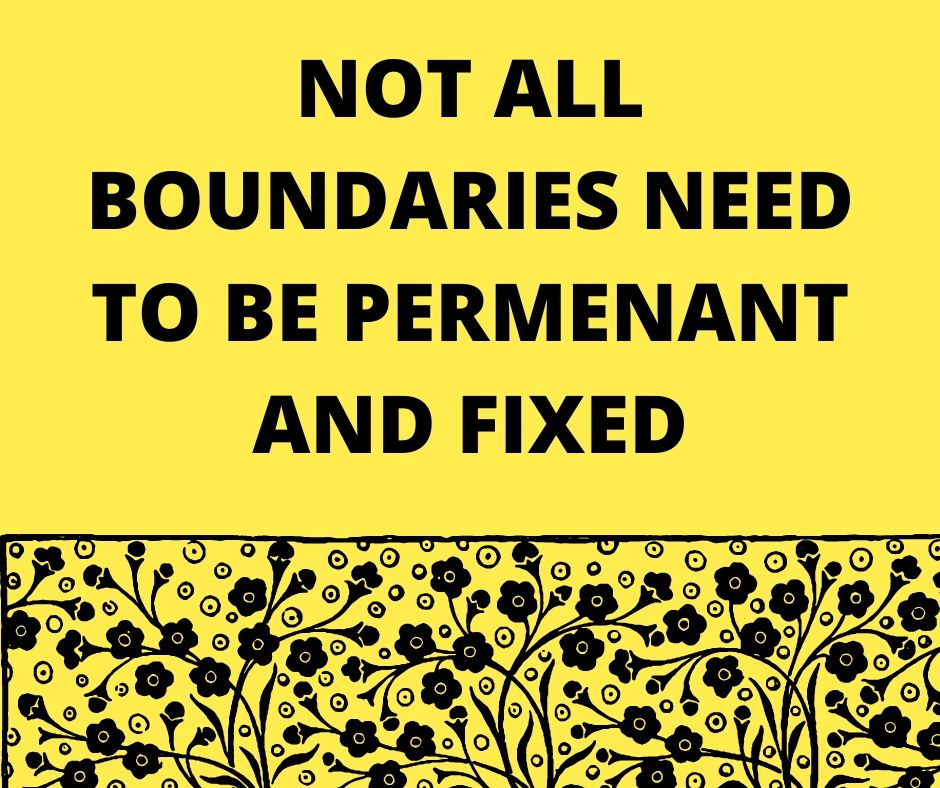
Here is an example. A lifelong friend and I were constantly discussing the issues in our respective marriages. It seemed that because we were discussing these things, we each were developing negative feeling towards each others husbands. Every conversation seemed to be turning into a husband bashing session and I became aware of what was happening. I set a firm boundary that we needed to not discuss our husbands or our personal issues with one another. After a few years, of this being successful, it was time to reevaluate our boundaries based on each one of our personal growths. We decided that we could discuss our husbands and our relationships as long as we did it with respect to our husbands and realized we were both using this time to sort out our our feelings and find solutions. This changing of the boundaries led to many positive conversations. It’s important to remember that it’s your boundary and your consequence and you get decide if and when you want to change it.
Boundary setting was one of the hardest and most complicated communication techniques I have ever researched! The ins and outs of setting effective boundaries is complicated, takes soul searching and practice. We fail on our way to success and learn by not giving up! I like to look at boundaries as carrying an invisible shield. By setting boundaries, I am developing a shield that protects myself and my immediate environment from toxic behaviors and protects my core values and beliefs. Boundaries allow my relationships to improve and teaches people how I want to be treated. Put on your shield and discover how this tool can change your life!

To set effective boundaries:
- Remember the difference between an ultimatum and a boundary
- An Ultimatum is a final demand or condition
- A boundary defines what behaviors you will and will not allow in your life
- Make a list your things that disturb your calmness and things that go against your core values
- Eliminate anything from your list that is directed at changing another person’s behavior or their beliefs or can be addressed with clear communication

- You devalue your boundary if you explain or debate it
- Not all boundaries need to be permanent or fixed


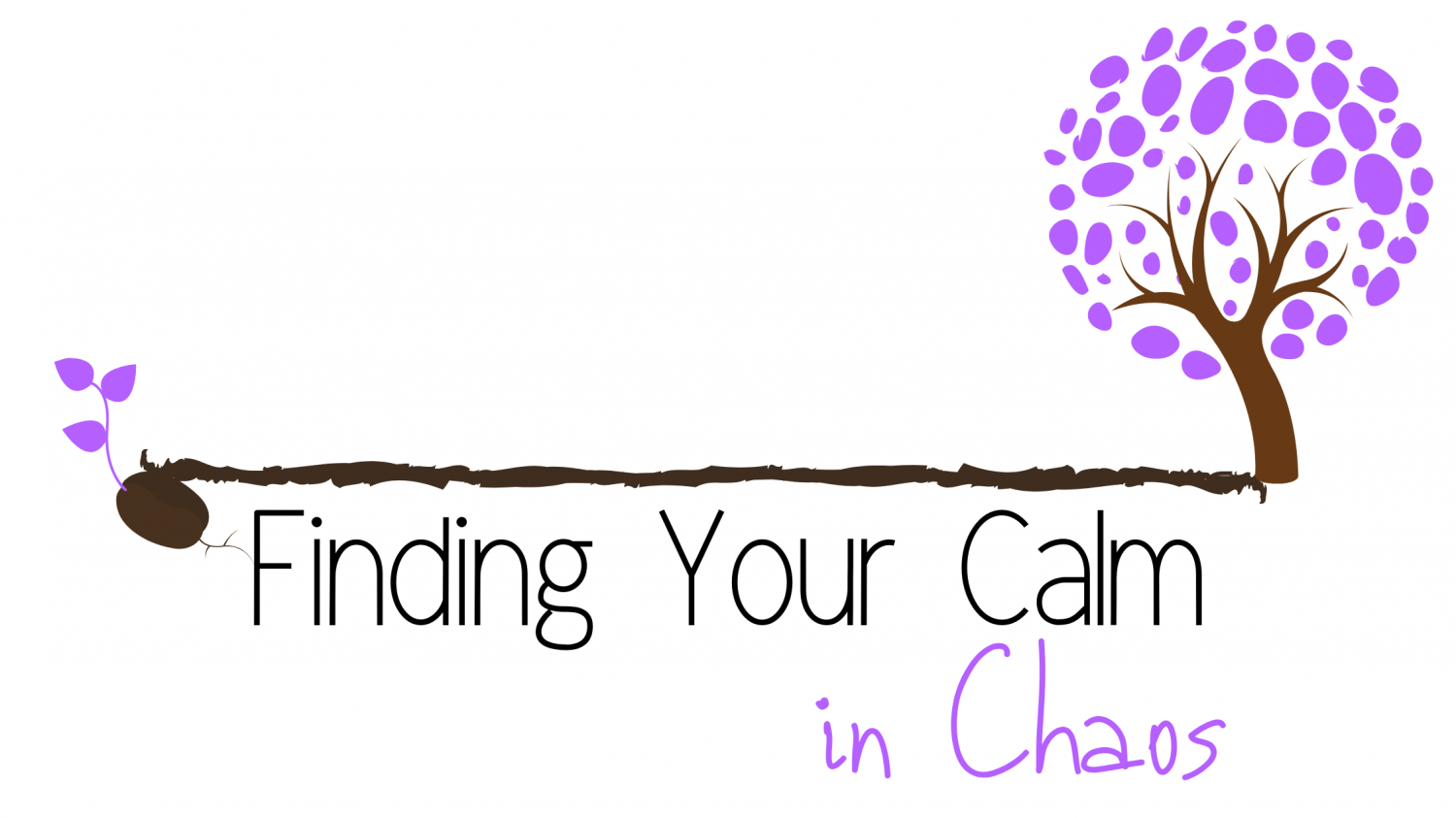


Oh my goodness. This is the clearest explanation of boundaries I’ve ever read. THANK YOU!
LikeLiked by 1 person
Thank you!
LikeLike